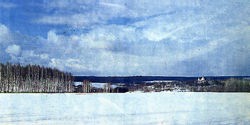It was 150 km from Moscow, at Borodino on 7 September 1812, that the most important battle of the Russian campaign took place. Napoleon's army (130,000 men, 28,000 cavalry and 587 cannon) faced the armies of Russia led by Kutusov (135,000 men, 25,000 cavalry and 624 cannon). The fighting lasted 15 hours and the uninterrupted cannon fire, according to those who were there, sounded like rolling thunder.
The casualties and loss of life at the Battle of Borodino were staggering: 20,000 wounded, 10,000 dead on the French side, amongst whom were the generals Montbrun, Caulaincourt, Compère, Plauzonne, Lanabère, Romeuf, Marion, and Tharreau, whilst on the Russian side there were 35,000 wounded and 15,000 dead, amongst whom the generals Bagration, Kutaizov and Tutchkov.
Napoleon's own description of the horror of this “clash of Titans” is particularly apt: “Of the fifty battles I have fought, the most terrible was that before Moscow. The French showed themselves to be worthy victors, and the Russians can rightly call themselves invincible“. In France, the Battle of Borodino is known as the Battle of Moscowa, taken from the name of the river which runs to the north of the battle ground. In fact, Napoleon insisted that the battle be called this so that it should stand as a reminder that the battle took place “before the walls” of the Russian capital.
The visit to the site begins at the village of Gorki which was general Kutusov's headquarters during the battle. In 1912, a black marble plinth with an eagle soaring above it was placed at the beginning of the village so as to mark the importance of the site. At the foot of the monument there is a large plaque showing all the commemorative monuments to be seen on the site.
In the village of Borodino itself there is a small museum with models, representations, arms and uniforms from the battle on show. A broad street in front of the museum leads to the “Great Redoubt” which is were general Rayevski's artillery was stationed. Traces of the trenches can still be seen and an immense monument erected by the Russians in commemoration of the 175th anniversary dominates the site. Behind this is the tomb of general Bagration who died in the fight.
Beyond the “Great Redoubt”, just after the village of Semenovskoye, is the site known as the “Three Arrows” or “Bagration's Arrows”. Nearby is the house where Tolstoy wrote “War and Peace”, now a museum dedicated both to the author and the battle.
Carrying on as far as Shewardino, you come to the Schewardino Redoubt which was built and fortified by the Russians. This was taken by the French on 5th September 1812. A few metres from the “Schewardino Redoubt” is the only monument on the battle field to the French. First erected in 1913 (subsequently destroyed and then re-erected in the 1980s on the initiative of the journal La Sabretache), this granite obelisk crowned by an eagle with its wings spread is placed on the spot held by Napoleon on 7th September 1812. There are thirty-five other Russian commemorative monuments scattered over the battlefield where every first Sunday in September reconstructions of the principal episodes of the battle are held.
Karine Huguenaud (Trans. P.Hicks)


